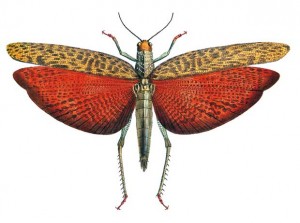
Reproductions from the book Ciência, história and arteAcrydium latreillei, included in Delectus animalium articulorum (1830-34), by Johann Baptist von Spix. Along with the botanist Martius, the zoologist Spix travelled through most of Brazil and produced magnificent drawings and narratives, such as this oneReproductions from the book Ciência, história and arte
The Library of the Biosciences Institute at the University of São Paulo (IB/USP) provided two contributions to the dissemination of science at the beginning of this year. The first was to organize a catalog of the rare and special works in its collection. The second was to illustrate it with some of the most beautiful and significant images from the collection itself, mostly by artists contracted by the scientists. These two activities yielded a catalog that looks like an art book, with the best of systematized science from the seventeenth to the nineteenth centuries. Ciência, História e Arte [Science, History and Art] (Edusp/Fapesp, 352 pages) was idealized and organized by Nelsita Trimer, the technical director of IB/USP’s library service. It was five years in the making.
Most of the works are from the eighteenth and the nineteenth centuries. The collection resulted from donations, from the acquisition of other collections, from the transfer of works from the library of the Polytechnic School and from the School of Pharmacy, and from important titles from the IB itself. The restoration of the 2,440 titles began 14 years ago thanks, mainly, to FAPESP funding, along with aid from the Vitae Foundation and from IB. “In the middle of the process I started thinking that we should publish a catalog with more rigorous descriptions than those that existed and to illustrate it with the beautiful images that were available,” says Nelsita. “Our rare and special works room is small, but it contains all the important natural science production from the last three centuries.” This includes the 40 volumes of Flora brasiliensis (1840-1906), by Carl von Martius, the 11 volumes of Florae fluminensis (1825-27), by Friar José Mariano da Conceição Vellozo, Historie naturelle, byBuffon (1825), Le règne animal (1827-38), by George Curvier and Edward Griffith, and other treasures.
“The work is highly important because of the collection that it classifies and reveals and its beauty is impressive, thanks to the care taken with the images and the texts,” says the linguist Carlos Vogt, who was FAPESP’s president at the time Nelsita presented the project and who was also one of the people that most encouraged it. Besides the technical description of the books, there are short reviews and profiles of scientists written by 12 researchers from IB. Take a look at these two pages at a sample of some of the images found in Ciência, história e arte.
Republish